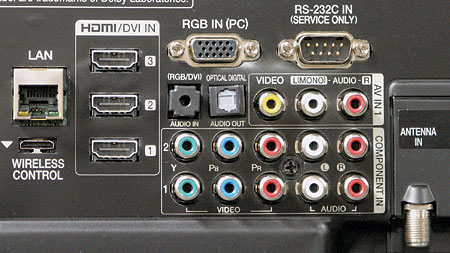LG Infinia 47LE8500 LCD HDTV Page 2
Caught in the Web
Today’s higher-end sets commonly include Web features, and the 47LE8500 is no exception. It offers a wide range of widgets for accessing Websites that LG has partnered with, including Yahoo!, Netflix, YouTube, and VUDU. While the LG doesn’t require a computer to access these Websites, you do need an Internet provider and a link from your router to the set.
The owner’s manual dedicates more than 60 pages to the LG’s Web features and using the set with a home network. Incidentally, LG only provides the manual in full form on a CD-ROM. The printed manual is a pamphlet that will help you get the set up and running, but it’s short on specifics.
Wireless
Out of the box, the 47LE8500 is a conventionally wired HDTV. However, with the purchase of the AN-WL100W Wireless Media Box ($400), you can eliminate the wire that normally runs between your equipment rack and the TV. The Wireless Media Box comes with a small companion receiver that plugs into the back of the 47LE8500 with two short connecting cables. One of them is a control cable, and the other is an HDMI lead for connecting to one of the set’s HDMI inputs. It’s powered through the control cable. The receiver attaches to the rear of the set near the input jacks, where it adds just under an inch to the overall depth.

Once you plug your sources into the optional AN-WL100W Wireless Media Box’s rear jack panel and connect the receiver to the set, you’ll have a wireless link between those sources and the receiver. The Wireless Media Box has three HDMI inputs, two component video inputs (each with analog stereo), and RGB input with a shared stereo mini-jack input for RGB/DVI audio, an optical digital audio output, two service ports (one of them RS-232C), and inputs for the two provided IR blasters. You’ll only need the latter for sources that are located where their normal remote IR commands can’t reach them.
 However, the Wireless Media Box lacks an RF input for cable TV reception without a cable box, or for an over-the-air (OTA) antenna. This means you can’t feed an OTA antenna signal from the Wireless Media Box through the wireless link and into the set’s DTV tuner. You can still feed an antenna input directly to the set. In that case, the only way to get the audio from the set’s OTA input to your A/V receiver (presumably located near the Wireless Media Box) is if you run a wired optical digital cable between them. This kind of defeats the purpose of the AN-WL100W—at least if you watch a lot of OTA television and want to get the best sound from that source.
However, the Wireless Media Box lacks an RF input for cable TV reception without a cable box, or for an over-the-air (OTA) antenna. This means you can’t feed an OTA antenna signal from the Wireless Media Box through the wireless link and into the set’s DTV tuner. You can still feed an antenna input directly to the set. In that case, the only way to get the audio from the set’s OTA input to your A/V receiver (presumably located near the Wireless Media Box) is if you run a wired optical digital cable between them. This kind of defeats the purpose of the AN-WL100W—at least if you watch a lot of OTA television and want to get the best sound from that source.
Over the limited range of distances and angles I tried (15 to 20 feet, nearly 90 degrees, no obstructions), I received a flawless image up to 1080p/60. But short gaps constantly interrupted the audio, which rendered the ANWL100W unusable. We couldn’t determine by press time if this was a sample fault or a generic problem.
Of course, you can run audio directly from your components to an outboard A/V receiver and bypass these audio issues. Given the set’s so-so audio performance, you’ll likely do that anyway. This also means that you’ll have to fire up the whole system just to hear the 6 o’clock news. You could use the set’s DTV tuner for this—if your source is an antenna. But in that case, see my comments above about the need for a wired connection back to the AVR if you want to hear the DTV tuner’s audio through your main system.
How Do I Like Thee
The LG’s video processing in the Expert1 mode was excellent in both HD and SD, apart from a failure on both the SD and HD 2:2 tests with the Real Cinema control either on or off. On worked best with the other tests. See the Video Test Bench for the full results.
The manual states that the set isn’t compatible with a 480i input over HDMI, but it willingly displayed my 480i HDMI sources. Its 480p-to-1080p video scaling was the best I’ve seen since we began testing for it last year.
Even before a full calibration, the LG’s color performance showed promise. After calibration, it was outstanding, with only minor shortcomings. I could only detect these by measurement (see HT Labs Measures). They weren’t obvious in any way on normal program material—or on test patterns. With the exception of creatively skewed sources, fleshtones never looked off, and bright greens kept their cool. When I correctly set the Color and Tint controls, they offered a level of naturalness that will only appear strange if you’re used to a poorly set-up and uncalibrated display.





























































